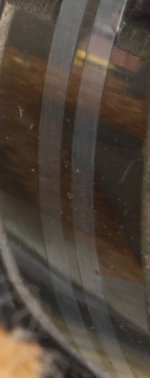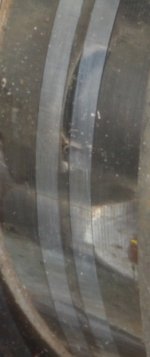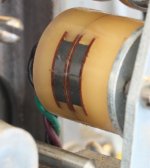I'm definitely interested in seeing pictures of your progress..
Since you are going to rewind the transformer I suggest you take lots of pictures as you take it apart for reference. You will need to replicate all of the small details otherwise the transformer is likely to be very noisy and possibly fail again. (I have rewound other transformers with mixed success..)
I would count the turns ratio on a couple of the lower voltage windings and use that to calculate the turns required for the other windings. You of course need to know what the AC voltage on that secondary was meant to be, but the schematics do provide some good information in that regard.
I would recommend that you not wind the same exact primary, but instead wind one that conforms to the current EU harmonization directive with just the taps required for the motors.. I assume like the rest of the EU the "official" line voltage is now 230V in Denmark.. This would save you a lot of work.
Since you are going to rewind the transformer I suggest you take lots of pictures as you take it apart for reference. You will need to replicate all of the small details otherwise the transformer is likely to be very noisy and possibly fail again. (I have rewound other transformers with mixed success..)
I would count the turns ratio on a couple of the lower voltage windings and use that to calculate the turns required for the other windings. You of course need to know what the AC voltage on that secondary was meant to be, but the schematics do provide some good information in that regard.
I would recommend that you not wind the same exact primary, but instead wind one that conforms to the current EU harmonization directive with just the taps required for the motors.. I assume like the rest of the EU the "official" line voltage is now 230V in Denmark.. This would save you a lot of work.
Bump
Wondered how Freak once's G36 project went.
I have a machine blowing the 1a fuse on the back (atop the valves).
I've tracked that one through a black lead back to mains transformer connected to the top rectifier (b30c600) and the 3x600uf electrolyte condenser. So my guess is that it's either those or the mains transformer.
I'm a noob though and don't really know how to measure rectifiers and transformers.
Wondered how Freak once's G36 project went.
I have a machine blowing the 1a fuse on the back (atop the valves).
I've tracked that one through a black lead back to mains transformer connected to the top rectifier (b30c600) and the 3x600uf electrolyte condenser. So my guess is that it's either those or the mains transformer.
I'm a noob though and don't really know how to measure rectifiers and transformers.
Disconect the transformer from the rest off the circuit (the rectifier), measure with the ohm meter accross the electrolytes, should not be a short there. If it is, than either one of the caps or the circuit is shorted. Switch the unit on and measure with the meter AC volt, on the transformer, if voltage is there ,the transformer is OK. Most likely the rectifier is defective.
For those who haven't seen it, a G36 has just gone for six and a half thousand pounds on ebay UK!
(not even with the new heads!)
(not even with the new heads!)
looks like the world economy is not in trouble?
GBP6500 for a revox G36...
I could get several ampexes or studers at that price
GBP6500 for a revox G36...
I could get several ampexes or studers at that price
Steerpike said:For those who haven't seen it, a G36 has just gone for six and a half thousand pounds on ebay UK!
(not even with the new heads!)
You've got to be kidding, that's over $10K U.S. .
 I have a very nice one and paid very little money for it relatively speaking (About 5% of this auction price, including what I paid for new heads.) ..
I have a very nice one and paid very little money for it relatively speaking (About 5% of this auction price, including what I paid for new heads.) .. Edit: I just found it, not listed as a G36, and closed yesterday (March 2nd) at £6,468.00, just silly, trying to look at the auction to see if there is something more to it. The cause of all the interest is apparently that this G36 was never used at all, but sat in a display case for 44yrs. I have a MKIII, this is a much earlier version - I've never worked on one with a head cover that looks like this.
For the curious here is the link, it probably will not be active for long so look now:
http://cgi.ebay.co.uk/REVOX-PROFESS...286.c0.m14&_trkparms=66:2|65:13|39:1|240:1318
No need to log in..
miklos said:Disconect the transformer from the rest off the circuit (the rectifier), measure with the ohm meter accross the electrolytes, should not be a short there. If it is, than either one of the caps or the circuit is shorted. Switch the unit on and measure with the meter AC volt, on the transformer, if voltage is there ,the transformer is OK. Most likely the rectifier is defective.
Thanks Miklos
My multimeter only goes to 32uf and the electrolyte in question is 600uf. Is there a trick to getting a measurement. I'm still not sure how you measure the rectifier.
If anybody knows of a good site where these basics are covered it'd be most welcomed
Thanks
Also what are the modern day equivalents of those big 3 legged electrolytes ? I've been looking around and can't seem to find any replacements.
Also what are the modern day equivalents of those big 3 legged electrolytes ? I've been looking around and can't seem to find any replacements.
You can get small PCB mount radial caps that are electrically equivalent. Physically mounting them is a bit untidy - you need to be inventive.
Some, who like to keep the right 'look' open up the old cans, take out the innards and put the 3 modern caps inside, then pack it up with resin or epoxy.
(If I need to replace mine's, what I will do is take out the 3 big plessey caps and the 3 rectifiers on that same bracket. Then make a printed circuit board that fits in that space, with silicon bridge rectifiers and radial PCB caps on the board.)
Right, so I got it up and running. It sounds ok, but there's definately loss of treble and bass, nothing massive but when compared to the source it's there.
The tape I have is possibly not the greatest in the world, looks like a pretty well used Basf thing.
Heads look ok. Cleaned them with white spirit as that is all I have at the moment. Wiped well afterwards.
What is the biggest contributor to lack of high and bottom end.
Or is that part of the G36 sound ?
The tape I have is possibly not the greatest in the world, looks like a pretty well used Basf thing.
Heads look ok. Cleaned them with white spirit as that is all I have at the moment. Wiped well afterwards.
What is the biggest contributor to lack of high and bottom end.
Or is that part of the G36 sound ?
Probably the heads followed by an incorrect level of bias for the tape you are using. Also not all tapes have excellent HF extension even at 7.5ips speed.. I installed Nortronics half track heads on mine last year because the stock playback head had failed due to poor QC when built. I have very good overall frequency response, these heads significantly outperform the stock vintage ReVox heads which IMO are not that great. Properly biased the HF response extends well beyond 20kHz with the new heads. (IIRC around 26kHz or so using the ReVox limits with my particular set of heads.)
Be very careful what you use to clean the heads as they can be seriously damaged. Refer to the ReVox manual (you can find it online if you don't have it.) for cleaning recommendations. I have no idea what white spirits are, alcohol? Never, ever use rubbing alcohol to clean tape heads, it contains oils that will contaminate head surfaces and can ruin recording tape.
Also the heads and tape path do need to be demagnetized periodically otherwise you will erase the high frequency content of your tapes.
Note that the coupling capacitors on the output of the deck are sized for input impedances of 100K and above, if your pre-amplifier has a lower input impedance than this you will experience LF roll-off.
Mine sounds very well balanced and is transparent enough to highlight the sonic nature of the original source used. I currently use vintage BASF LPR35 recording tape on 10.5" reels.
Be very careful what you use to clean the heads as they can be seriously damaged. Refer to the ReVox manual (you can find it online if you don't have it.) for cleaning recommendations. I have no idea what white spirits are, alcohol? Never, ever use rubbing alcohol to clean tape heads, it contains oils that will contaminate head surfaces and can ruin recording tape.
Also the heads and tape path do need to be demagnetized periodically otherwise you will erase the high frequency content of your tapes.
Note that the coupling capacitors on the output of the deck are sized for input impedances of 100K and above, if your pre-amplifier has a lower input impedance than this you will experience LF roll-off.
Mine sounds very well balanced and is transparent enough to highlight the sonic nature of the original source used. I currently use vintage BASF LPR35 recording tape on 10.5" reels.
I was looking over the circuitry for my G36 last night, thinking if re-vivifying it.
I was reminded there is no bias change associated with a speed change, nor is there any adjustment for Eq, regardless of speed.
Has anyone ever addressed these omissions, and do such modifications give any remarkable results?
I was reminded there is no bias change associated with a speed change, nor is there any adjustment for Eq, regardless of speed.
Has anyone ever addressed these omissions, and do such modifications give any remarkable results?
Normally it is difficult to make decent recordings on used tapes.
If you have to do it, it is recommended to re bias the recorder ,and even so the recording will contain more dropouts and less highs, beacuse of the higher bias.
Also watch out for sticky tapes, which would soil in short time the head surface and cause HF loss.
If you have to do it, it is recommended to re bias the recorder ,and even so the recording will contain more dropouts and less highs, beacuse of the higher bias.
Also watch out for sticky tapes, which would soil in short time the head surface and cause HF loss.
Steerpike said:I was looking over the circuitry for my G36 last night, thinking if re-vivifying it.
I was reminded there is no bias change associated with a speed change, nor is there any adjustment for Eq, regardless of speed.
Has anyone ever addressed these omissions, and do such modifications give any remarkable results?
The bias is adjustable for use with different formulations. (But not different speeds) The EQ is switchable with speed, but is not adjustable. It really doesn't need to be if the head quality is consistent and known - the time constants are defined by either NAB or IEC standards depending on what market the deck was built for.
Machines designed to support either standard generally have pots to allow for adjustment to either standard, mainly as a means of reducing component complexity and to allow for some tweaking of frequency response based on (improved) tape formulation(s) and head geometry.
My Otari supports both NAB and IEC formats, and has pots that need to be tweaked for the highest speed to be used, and for the switch selectable EQ chosen. You start with a standard alignment tape for the speed used and adjust both HF response and LF response (compensates for head bump) then once playback response is as desired you do the same thing for the record circuitry adjusting bias, HF response and LF response for flatest overall response. I've simplified, but suffice it to say I am delighted that the ReVox does not require these adjustments and sounds quite nice with the default EQ and bias tweaked for the tape used.
I can't recommend ever recording at 3.75ips, so all tweaking should be done for 7.5ips unless you are one of the lucky few who owns a G36 capable of 15ips operation. (These are quite rare.)
Thanks for the help with the tape heads.
My problems just came back though. It was running great for quite a few hours when after a tape rewind I pushed play and the brakes didn't wanna let go. Stood there for a couple of seconds then the top fuse (next to the external speaker socket) went. I changed the fuse, pushed ffwd and it blew again instantaniously.
I think I read about this somewhere but I can't find the link again. Seems to be a rather common problem. Any hints ?
My problems just came back though. It was running great for quite a few hours when after a tape rewind I pushed play and the brakes didn't wanna let go. Stood there for a couple of seconds then the top fuse (next to the external speaker socket) went. I changed the fuse, pushed ffwd and it blew again instantaniously.
I think I read about this somewhere but I can't find the link again. Seems to be a rather common problem. Any hints ?

The EQ is switchable with speed, but is not adjustable. It really doesn't need to be if....
I was comparing it with my PR99, which is not dual-eq (unless you count swapping out PC boards). But the PR99 and B77 had adjustable Eq for fast & slow, and separate bias for fast & slow.
Certainly 3-3/4 ips isn't going to get the best sound, but I was wondering if it might be maximised by optimally adjusting bias at that speed. And a bit of eq tweaking might not go amiss at any speed.
2 legged transistor looking things
Zounds! I think you've found the silicon diodes!
The heads look OK, from the degree of zooming I can do on those pics. The horizontal space in the record head is normal, and record heads DO have a wide gap. The erase head has an even wider gap - its not a fault.
The light flecks i assume are dirt or dust. If they are holes or corrosion in the pole-piece, thats a worry.
- Home
- Source & Line
- Analogue Source
- Restoring ReVox G36 MKIII - Expert Opinions Solicited


